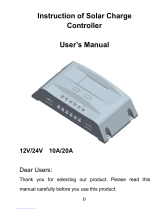M
ECHANICAL
• Dimensions: (inches) ........... 6.01 (W) x 4.14 (H) x 2.17 (D)
(mm) ............... 153 (W) x 105 (H) x 55 (D)
• Weight: (oz) ................. 12
(kg) ................. 0.34
• Wire terminals .....................Euro-style
Max wire size:
(solid).............. #6 AWG/16 mm
2
(multistrand) ... #6 AWG/10 mm
2
(fine strand) .... #8 AWG/10 mm
2
Terminal diameter ........... 0.2 inch/5 mm
• Mounting orientation ......... vertical
• Case:
Material ........................VALOX #310 SEO
Fungicidal resistance ....... ASTM G21-70
Moisture absorption ........ < 0.4%
UL Thermal Index ............ 120°C/140°C
E
LECTRONIC
F
USE
/ S
YSTEM
S
AFETY
• Load short-circuit................ Short-circuit is > 10X load
rating for > 5 msec
........................Load disconnected < 50
microsec
• Emergency disconnect ....... If voltage < 2.4 V, PV/load
disconnected < 0.1 sec
• Reverse polarity.................. All 4 system inputs fully
protected
• High temp shutdown.......... 70°C disconnect PV input
80°C disconnect load
60°C reconnect load
50°C reconnect PV
C
ONTROL
S
ETPOINTS
12 Volt
Sealed Flooded
• Low volt load disconnect 11.4 11.5
• LVD reconnect 12.5 12.6
• Constant-voltage regulation 14.1 14.3
• Equalization 14.35 14.6
• HVD 15.5 15.5
(24V setpoints are twice 12V values)
C
ONTROL
P
ARAMETERS
• Charge algorithm ............... constant-voltage
PWM pulse charging
series configuration
• Temp comp coefficient ...... - 5.0 mV/°C/cell (25°C ref)
• LVD current coefficient ....... - 20 mV/amp load
• Auto equalize:
Sealed ........................16 days or 11.9/23.8 V
Flooded ........................11 days or 12.0/24.0 V
• Temp comp setpoints ........ Regulation, Equalize, HVD
• Software delays .................. LVD = 55 sec; HVD = 7 sec
• Software filtering ................ average 2 inputs/50 µsec
• Measurement rate .............. 37.5 samples/sec
Specifications subject to change without notice.
R
ELIABILITY
5-year failure rates at a 90% confidence level
• ProStar-12 .................................... < 0.1%
• ProStar-20 .................................... < 0.1%
• ProStar-30 .................................... 0.4%
E
NVIRONMENTAL
• Operating temperature ................ -40 to +85°C
• Max ambient temperature ........... +60°C
• Storage temperature .................... -55 to +100°C
• Humidity ....................................... 100% (NC)
P
ERFORMANCE
/ E
LECTRICAL
• Accuracy 12V ........................... +/- 22 mV
24V ........................... +/- 38 mV
• Maximum array voltage................ 50 V
• Min voltage to operate ................ 8.0 V
• Ground ................................. negative
• Parallel capability ......................... yes
• Self-consumption (tare):
Night ................................. 11 mA
Charging ................................. 12 mA
Load disconnected................... 10 mA
• Voltage drops:
Maximum:
PV/Batt ..................... 0.7 V
Batt/Load ................. 0.4 V
Typical: PV/Batt ..................... 0.5 V
Batt/Load ................. 0.1 V
• Operating life ............................... 15 years
• Noise:
µP protection ........................... all inputs
Output noise pulses ................. < 400 mV
Noise pulse width .................... < 500 nanosec
Radiated noise ......................... < 100 picowatts/Khz
• FET’s:
Rds (on resistance) ................... 0.018 ohm
Pulse rating .............................. 120 A
Junction temp rating ................ 175°C
Operating junction temp ......... 110°C
• µP memory ................................. 2k ROM
• µP clock speed ............................. 2 Mhz
• Transient surge suppressors:
Pulse power rating ................... 1500 watts
Response ................................. < 5 nanosec
• LED’s:
Pulse rate ................................. 300 Hz
Current consumption ............... < 1 mA/LED
M
ETER
D
ISPLAY
• Type ............................................. LCD
• Display.......................................... 3-digit x .5 inch
• Temp rating.................................. -30 to +85°C
• Voltage accuracy .......................... 0.5%
• Current accuracy .......................... 2.5%
• Status LED’s ................................. 3
• Self-consumption (tare) ................ 8.5 mA
• Manual disconnect ....................... < 100 microsec
M
ODEL
R
ATINGS
ProStar-12 ProStar-20 ProStar-30
PV current (amps) 12 20 30
Load current (amps) 8 16 30
Note: Current ratings can be exceeded by 25% for up to 5 minutes.
• All models both 12V
and 24V (automatic
selection)
Manufactured in the U.S.A.
















